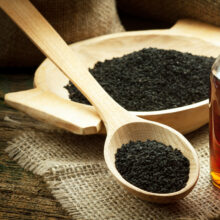The Benefits of Eating Ancient Grains & Seeds
- Published: Thursday, September 18th 2014
- in Nutrition
 Over the past few years ancient grains and seeds have become a staple in many health-conscious households but more recently we’re seeing ingredients like chia, quinoa, amaranth, and more popping up in more mainstream items like chocolate bars and tortilla chips. Whether you want them mixed in or on their own, ancient grains and seeds are something you should be eating. Reason being? They are high in fiber and protein, are often low-gluten or gluten-free for those concerned, and they contain lots of vitamins and minerals that a healthy diet craves.Check out some of our favorites and their benefits below!
Over the past few years ancient grains and seeds have become a staple in many health-conscious households but more recently we’re seeing ingredients like chia, quinoa, amaranth, and more popping up in more mainstream items like chocolate bars and tortilla chips. Whether you want them mixed in or on their own, ancient grains and seeds are something you should be eating. Reason being? They are high in fiber and protein, are often low-gluten or gluten-free for those concerned, and they contain lots of vitamins and minerals that a healthy diet craves.Check out some of our favorites and their benefits below!
Complete Proteins: Amaranth, Chia, Quinoa
Amaranth
Amaranth, once believed to be the food of the gods, is a great source of gluten-free protein and the essential amino acid lysine. The grain, which is an anti-inflammatory, helps to prevent cardiovascular disease, hypertension, and even contains vitamin C. When cooked the inside will soften while the outer “shell” keeps its crunch, making it a perfect addition to homemade energy bars (recipe here) and salads!
Chia
Chia seeds, by far my personal favorite on this list, are known for being high in omega-3 fatty acids and are even touted for helping to keep our brains sharp by improving memory! The little power players contain fiber, protein, calcium, phosphorus, and manganese and can be consumed in an endless variety of ways. Mix them with a little water and let them soak, the seeds are hydrophilic and they can absorb liquid, giving them a gel coating and jello-like texture. You can eat them plain mixed with water, in yogurt and oatmeals, in a smoothie (like this one with cashew butter and cinnamon), or mixed with a little cheese to stuff mushrooms (my favorite recipe here).
Quinoa
Another complete protein, quinoa has finally made it’s way to staple-status, showing up on restaurant menus and in households alike. In addition to protein, quinoa contains all nine essential amino acids necessary for tissue growth and repair! As well, it’s is gluten-free, low-glycemic, and high in fiber, and magnesium. We love it as a side dish and a main course, try this Toasted Quinoa and Seasonal Vegetable Salad for your next vegetarian meal!
Hemp
Before you rustle up images of Cheech and Chong, hacky sacks, and the smell of patchouli, take a second to open your mind to the nutritional benefits of hemp seeds. You can get it from your local health food store as an oil, seed, milk, flour, or ground meal. They contain essential fatty acids including linoleic acid, omega-6 and -3, and ALA. As well, hemp is high in digestible protein and amino acids. You can eat them raw, pop them on the stove top to sprinkle on top of salads, or mix them into your smoothies! And, just in case you’re wondering… they won’t get you high.
Farro
This ancient grain gets lots of love in Italy, likely due to its cashew-like taste and chewy texture. But this low-gluten grain does more than taste good. It’s also packed with fiber, vitamins B and E, protein, and magnesium. You can purchase farro in three forms, whole (which needs to be soaked overnight to cook and has the most nutritional benefit, semi-pearled, and pearled (which is easiest to cook but you forsake a lot of nutrition for the ease of cooking). Try farro in this Curves Complete recipe!
Freekah
Popular in Middle Eastern cuisine, freekah is a low-glycemic cereal food that contains a whole lot of fiber (multitudes more than comparable grains including quinoa). It’s similar to farro in taste and texture and can be cooked just like a rice but eaten as a cereal, in soups, salads, or alone as a side dish with mixed veggies.
You may also enjoy:
- Go with the Grain: 12 Whole Grains Recipes
- Why You Should Be Eating Ancient Grains + a Farrotto Recipe
- Amaranth: An Ancient Grain Revisited


